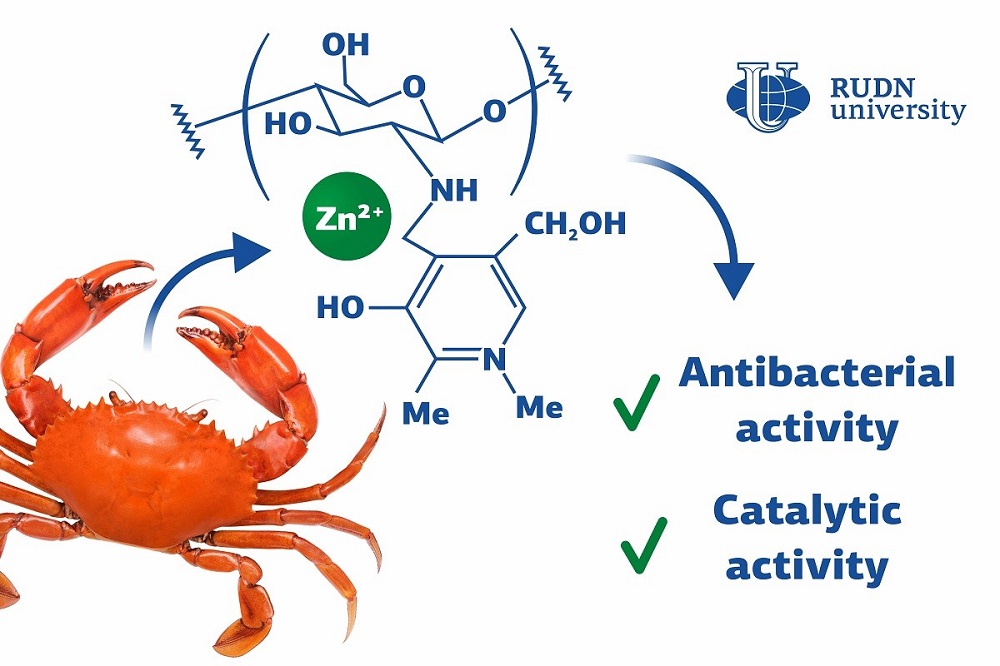RUDN chemists synthesized a chitosan multifunctional composite material

Chitosan, which is derived from chitin, the main substance in the shells of crustaceans and other arthropods, is interesting for “green chemistry” because of several properties. It is made from available raw materials, and the materials made from it are generally biocompatible, non-toxic, and easily degradable under natural conditions. In addition, they are polymers, long molecules-chains of repeating links, the modification of which allows you to give the material new properties.
“In previous studies, we were able to obtain a chitosan-based polymer with both catalytic and antibacterial properties using ultrasound treatment. It is known that the integration of metal ions into the polymer matrix makes it possible to strengthen such materials and improve their characteristics. The most suitable metal compounds for modifying our materials are complexes with divalent zinc, which also exhibits antibacterial and catalytic activity,” Andrey Kritchenkov, PhD, assistant of the RUDN Department of Inorganic Chemistry.
At the first stage of the experiment, the researchers compared the new approach to the synthesis of chitosan derivatives with the standard one. Using ultrasound allowed RUDN chemists to obtain a derivative of chitosan and iodine-containing aromatic aldehyde much faster than under conventional conditions. To 60% of the original units of chitosan joined hydrocarbon rings aldehyde, it took 10 minutes instead of three hours. In addition, ultrasound reduced the volume of aldehyde required for the reaction by 2.6 times. The reaction temperature in both cases did not exceed 25°C. The chitosan derivative was then treated with a small amount of zinc chloride and caustic soda. A composite material was formed in which each chitosan link carried an aldehyde-derived ring of atoms and a zinc cation.
For comparison, RUDN chemists synthesized a similar composite with the inclusion of zinc from pure chitosan. The catalytic effect of the new materials was evaluated in a three-component Mannich reaction, which allows simultaneously forming a new bond between carbon atoms and adding a functional group to the compound. The composite based on a chitosan derivative proved a more effective catalyst compared to both zinc-modified chitosan and inorganic zinc compounds. At the same time, the new material can be used in catalysis six times in a row due to its resistance to high temperature. In tests of antibacterial properties, the new composite was compared with the same catalytic agents as well as with the antibiotics ampicillin and gentamicin. All substances proved to be detrimental to E. coli (Escherichia coli) and Staphylococcus aureus bacteria, but the medical drugs were nevertheless two or more times more effective.
“The composite material based on a chitosan derivative with zinc showed impressive catalytic properties and antibacterial activity comparable to that of known antibiotics. To find out how these qualities are related to the structure of the material, we continue the project and synthesize similar materials in reactions with other aldehydes”, says Andrey Kritchenkov, PhD, assistant of the RUDN Department of Inorganic Chemistry.
The article was published in Aquaculture Mendeleev Communications.
Matilda Pavlovna Mityaeva was born in 1925. In November 1942, she volunteered for frontline duty. She participated in the Great Patriotic War from November 1942 to June 1945 as part of the 53rd Infantry Division of the 475th Infantry Regiment. She was wounded twice.
The team led by Sergey Zyryanov, Head of the Department of General and Clinical Pharmacology, became the winner of the All-Russian competition of scientific projects "Technologies for Human Health".
RUDN University constantly adapts to the changes of the modern world and responds to challenges flexibly. This allows us to keep the standard of a world-class research university. The sphere of science is no exception. Peter Dokukin, Head of the Research Division, presented the updated R&D Programme at the meeting of the RUDN University Academic Council.
Matilda Pavlovna Mityaeva was born in 1925. In November 1942, she volunteered for frontline duty. She participated in the Great Patriotic War from November 1942 to June 1945 as part of the 53rd Infantry Division of the 475th Infantry Regiment. She was wounded twice.
The team led by Sergey Zyryanov, Head of the Department of General and Clinical Pharmacology, became the winner of the All-Russian competition of scientific projects "Technologies for Human Health".
RUDN University constantly adapts to the changes of the modern world and responds to challenges flexibly. This allows us to keep the standard of a world-class research university. The sphere of science is no exception. Peter Dokukin, Head of the Research Division, presented the updated R&D Programme at the meeting of the RUDN University Academic Council.